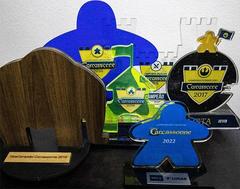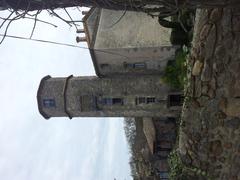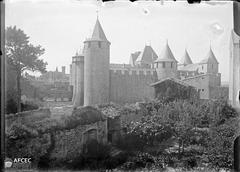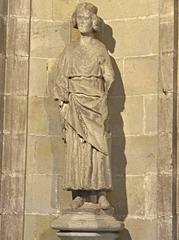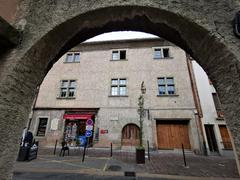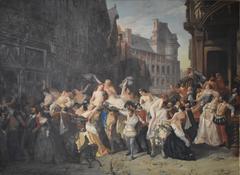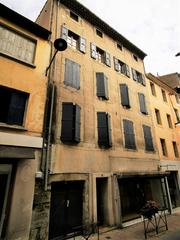Musée des Beaux-Arts de Carcassonne: Visitor Information, History, and Tips
Date: 19/07/2024
Introduction
The Musée des Beaux-Arts de Carcassonne, nestled within the fortified city of Carcassonne, offers a captivating journey through centuries of artistic excellence. Established in 1836, the museum has evolved into a cultural beacon, showcasing an extensive collection of fine arts, including paintings, sculptures, and decorative arts from the 16th to the 20th centuries. The museum’s rich history reflects the dynamic artistic trends and societal values of different eras, particularly highlighting the artistic heritage of the Languedoc-Roussillon region. As a key attraction within this UNESCO World Heritage site, the museum not only preserves regional heritage but also promotes artistic appreciation and cultural tourism. Visitors can explore its diverse collection and participate in various special events and guided tours, making it an essential destination for art enthusiasts and history buffs alike. For more information, visit the Musée des Beaux-Arts de Carcassonne official website.
Table of Contents
- Introduction
- History and Significance
- Collections and Exhibits
- Visitor Information
- Special Events and Guided Tours
- FAQ
- Conclusion
- Sources
History and Significance
Early Beginnings (1836-1900)
The museum’s origins can be traced back to 1836 with the establishment of the Société des Arts et des Sciences de Carcassonne. This society, comprised of local intellectuals and art enthusiasts, sought to create a space for showcasing and celebrating art and science. Their efforts led to the formation of the museum’s first collection, initially housed in the former Bishop’s Palace.
The early collection primarily comprised donations from private individuals and the French state. Notable among these early acquisitions were works by regional artists, providing a glimpse into the artistic landscape of the Languedoc-Roussillon.
Expansion and Transformation (1900-1950)
The turn of the 20th century marked a period of significant growth and transformation for the museum. In 1907, it was relocated to its current home, the former Hôtel de Laurens. This grand 18th-century mansion, with its elegant architecture and spacious interiors, provided a fitting backdrop for the expanding collection.
The museum’s focus also began to shift during this period. While it continued to acquire works from earlier centuries, there was a growing emphasis on contemporary art. This reflected a broader trend in the art world, with museums increasingly recognizing the importance of showcasing the art of their time.
Post-War Period and Modernization (1950-Present)
The decades following World War II saw the Musée des Beaux-Arts de Carcassonne undergo further modernization and expansion. The museum benefited from increased public funding, allowing for renovations, improved display spaces, and the acquisition of new works.
A significant development during this period was the establishment of a dedicated space for modern and contemporary art. This reflected the museum’s commitment to representing the full spectrum of artistic expression, from historical masterpieces to cutting-edge contemporary creations.
Significance and Impact
The Musée des Beaux-Arts de Carcassonne holds significant cultural and historical importance, both for the city of Carcassonne and the wider Languedoc-Roussillon region.
- Preserving Regional Heritage: The museum plays a vital role in preserving and showcasing the artistic heritage of the Languedoc-Roussillon. Its collection provides a unique window into the region’s artistic evolution, from the Renaissance to the present day.
- Promoting Artistic Appreciation: Through its exhibitions, educational programs, and outreach initiatives, the museum fosters an appreciation for art among residents and visitors alike. It serves as a valuable resource for art education and cultural enrichment.
- Cultural Tourism: The Musée des Beaux-Arts de Carcassonne is a key attraction within the fortified city, drawing visitors from around the world. Its presence contributes to the city’s cultural vibrancy and tourism industry.
Today, the Musée des Beaux-Arts de Carcassonne stands as a testament to the enduring power of art and its ability to connect us to the past, present, and future. It remains a dynamic cultural institution, constantly evolving to meet the needs of its community and engage with the ever-changing world of art.
Collections and Exhibits
The museum houses a diverse and fascinating collection spanning several centuries, offering a captivating journey through art history. While it features a range of artistic movements and mediums, it particularly shines in its collection of 17th and 18th-century paintings, sculptures, and decorative arts.
Fine Arts
Paintings
-
17th-18th Century French Paintings: The museum boasts a notable collection of paintings from this era, including works by renowned artists like Jean-Baptiste Oudry, known for his animal paintings, and Nicolas de Largillièrre, a prominent portrait painter. Visitors can admire the technical skill and artistic sensibilities of these masters, gaining insight into the artistic trends and societal values of the time.
-
19th Century French Paintings: This section showcases the evolution of French painting, featuring works from various movements like Romanticism, Realism, and Impressionism. Artists represented include Théodore Chassériau, known for his Romantic and Orientalist themes, and Narcisse Diaz de la Peña, a prominent figure of the Barbizon School.
-
Regional Art: The museum takes pride in its collection of paintings by local artists, highlighting the artistic heritage of the Carcassonne region. These works offer a unique perspective on the local landscape, culture, and history.
Sculptures
-
Medieval Sculptures: A small but significant collection of medieval sculptures, including religious icons and architectural fragments, provides a glimpse into the artistic traditions of the region during the Middle Ages.
-
17th-19th Century Sculptures: This period is represented by a variety of sculptures, including busts, religious figures, and decorative pieces. These works showcase the evolution of sculptural techniques and styles over the centuries.
Decorative Arts
-
Furniture: The museum houses a collection of furniture pieces from different periods, reflecting the changing styles and craftsmanship of furniture making. Visitors can admire intricate details and learn about the evolution of design aesthetics.
-
Ceramics: A diverse collection of ceramics, including faience and porcelain, showcases the artistry and technical skill involved in ceramic production. Visitors can explore different styles and techniques, from delicate floral patterns to bold geometric designs.
-
Tapestries: The museum features a selection of tapestries, primarily from the 17th and 18th centuries. These intricate textiles, often depicting historical or mythological scenes, demonstrate the artistry and craftsmanship of tapestry weaving.
Temporary Exhibitions
In addition to its permanent collection, the Musée des Beaux-Arts de Carcassonne hosts temporary exhibitions throughout the year. These exhibitions often focus on specific themes, artistic movements, or individual artists, providing visitors with a deeper understanding of art history and contemporary art practices.
Note: Information about current and upcoming temporary exhibitions can be found on the official website of the Musée des Beaux-Arts de Carcassonne or through local tourism offices.
Highlights of the Collection
While the entire collection offers something for every art enthusiast, some pieces stand out as must-sees:
-
“The Death of Cato of Utica” by Jean-Baptiste Regnault: This large-scale historical painting, created during the Neoclassical period, depicts the dramatic suicide of the Roman statesman Cato the Younger. The painting’s grandeur and emotional intensity make it a captivating centerpiece of the collection.
-
“Portrait of a Woman” by Nicolas de Largillièrre: This exquisite portrait exemplifies Largillièrre’s mastery of capturing the likeness and personality of his subjects. The delicate brushwork, rich colors, and elegant pose of the sitter make this painting a true masterpiece.
-
“The Ford” by Narcisse Diaz de la Peña: This evocative landscape painting showcases Diaz de la Peña’s signature style, characterized by his use of light and shadow to create a sense of depth and atmosphere. The painting’s romantic sensibility and idyllic setting transport viewers to the heart of the Barbizon School.
-
Collection of Medieval Sculptures: While small, this collection offers a valuable glimpse into the artistic traditions of the region during the Middle Ages. The religious icons and architectural fragments, often carved from local stone, provide insights into the beliefs and artistic practices of the time.
-
18th Century Tapestries: The museum’s collection of tapestries, particularly those from the 18th century, is noteworthy for its quality and craftsmanship. These intricate textiles, often depicting scenes from mythology or history, showcase the skill and artistry of tapestry weaving.
Visitor Information
Visiting Hours and Tickets
- Opening Hours: The museum is open from Tuesday to Sunday, 10 AM to 6 PM. It is closed on Mondays and certain public holidays.
- Ticket Prices: Admission is free for all visitors, making it an accessible cultural destination for everyone.
Travel Tips
- Getting There: The museum is located within the fortified city of Carcassonne, a UNESCO World Heritage site. It is easily accessible by foot from the city’s main entrance. Public transport options and parking facilities are available nearby.
- Nearby Attractions: While visiting the museum, explore other historical sites within Carcassonne, such as the Château Comtal and the Basilica of Saints Nazarius and Celsus.
- Accessibility: The museum is wheelchair accessible, with ramps and elevators available for visitors with mobility needs.
Special Events and Guided Tours
- Special Events: The museum regularly hosts special exhibitions, workshops, and cultural events. Check the museum’s official website or contact them directly for the latest information on upcoming events.
- Guided Tours: Enhance your visit with a guided tour. Knowledgeable guides offer insights into the museum’s collection and the history of Carcassonne. Group tours can be arranged in advance.
FAQ
What are the opening hours of the Musée des Beaux-Arts de Carcassonne?
The museum is open from Tuesday to Sunday, 10 AM to 6 PM. It is closed on Mondays and certain public holidays.
How much are tickets to the Musée des Beaux-Arts de Carcassonne?
Admission to the museum is free for all visitors.
What are some nearby attractions?
Nearby attractions include the Château Comtal, the Basilica of Saints Nazarius and Celsus, and other historical sites within the fortified city of Carcassonne.
Conclusion
The Musée des Beaux-Arts de Carcassonne stands as a testament to the enduring power of art to connect us to past, present, and future. With its diverse collection of fine arts spanning multiple centuries, the museum offers a unique glimpse into the artistic and cultural evolution of the Languedoc-Roussillon region. From its early beginnings to its modern-day significance, the museum has continually adapted to showcase both historical masterpieces and contemporary creations. With free admission, accessible facilities, and a strategic location within the medieval city of Carcassonne, the museum is an inviting and enriching destination for all visitors. Whether you are drawn by the allure of 17th-century French paintings or the intricate beauty of decorative arts, the Musée des Beaux-Arts de Carcassonne promises a memorable and enlightening experience. For updates on exhibitions and events, follow the museum on social media or visit their official website.
